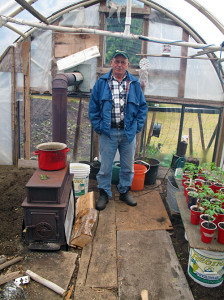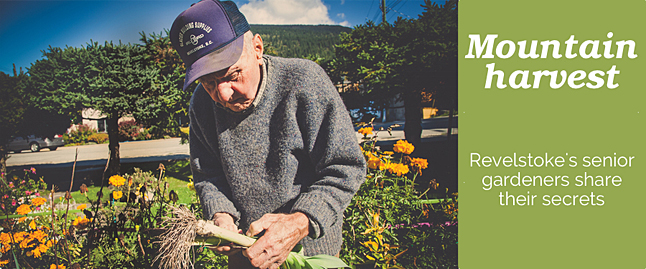Editor’s Note:
This excerpt from Laura Stovel’s new book, Mountain Harvest: Revelstoke’s senior gardeners share their secrets, is a loving examination of the master gardeners who are the pillars of gardening culture in our community. She has permitted The Revelstoke Current to publish a chapter of Mountain Harvest, and I sincerely hope you will enjoy this excerpt as much as I did. Mountain Harvest is available at Chantilly Kitchen, Bed ‘n’ Bath, Grizzly Books and the Revelstoke Museum & Archives. If you’d like to order a copy of the book, which is a North Columbia Environmental Society project, and can’t make it to one of the shops, you can contact Laura directly at lstovel0@gmail.com.
Here is the sample chapter. I hope you enjoy it:

Manuel Amaral
MASTER OF THE GREENHOUSE
with Josie Woodman and Barry Warren
Manuel Amaral grew up in the beautiful Portuguese Azores Islands. Times were hard and families survived by growing their own food and by family members taking on whatever paid employment was available – even children.
“My father grew everything,” Manuel said, and everyone helped with the family garden.
Manuel never had the opportunity to go to school. He started working in the construction industry at the age of five, running errands and doing whatever needed to be done. By the age of 12 he went to sea – all for the family cause. “We were raised in a way that if you make 50 cents you give it to your family.”
By the time he was in his 20s, Manuel was married to his life-long partner Emilia and was working piloting a ferry. His passengers often told him, “If you want to make money go to America.” Emilia had relatives in Revelstoke so, when Manuel was 29, he and Emilia packed their belongings and moved here with their young son, Joe.
It’s early March. Manuel Amaral puts another log in the small wood stove in his back-yard greenhouse. He has just planted tomatoes in flats that sit on shelves in a second, smaller greenhouse inside the first one. He used some saved seeds and some purchased ones: Jetset, Italian and Super Mario.
A big pot of water sits on the stove, keeping the greenhouse humid. Manuel also uses electric heat and runs a fan that circulates the air. As many good gardeners know, a breeze also helps the tomato stems grow strong. Manuel tries to keep the temperature at 75-80° F (24-27° C) throughout the winter.
Outside, the gutter from a nearby shed funnels rain water into four 45-gallon rain barrels. Once the snow has melted, plastic pipes will run from these barrels into the greenhouse, providing Manuel’s plants with the best quality of water. The pipes are perforated about every foot to selectively water the tomatoes once they have been transplanted into the rich soil in the greenhouse. “Rain water is best,” he said. He must be right. By early June, Manuel’s tomato plants were almost waist high and some had fruit the size of apples.
In early August, Manuel begins to cut the tops off the tomato plants that stand like tall, strong trees in the greenhouse. New blossoms are not likely to ripen into fruit any more so this pruning saves energy for the enormous and plentiful tomatoes hanging from the branches. During this stage, Manuel waters his tomatoes with buckets of warm water at the base of the plant. He says the tomatoes prefer warm water.
Manuel notes that his seeds saved from genetically-modified tomatoes produced much smaller fruit than the parent. By contrast the hefty Roma tomatoes, from which he has saved seed for many years, continue to produce large fruit. Manuel is not alone in making that observation.
In his rich life, Manuel has experienced great hardship and great happiness. He made his own opportunities – like his abundant garden. His philosophy is simple: “Life is short so there is no need to be miserable.”




